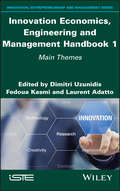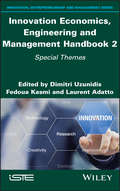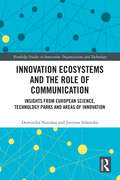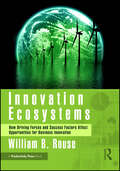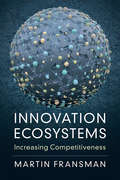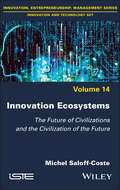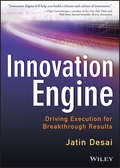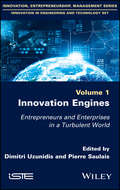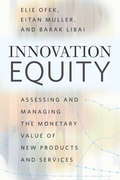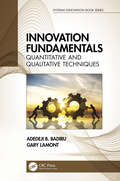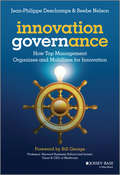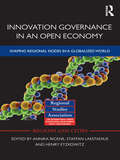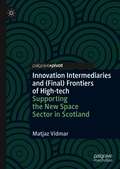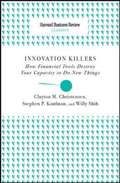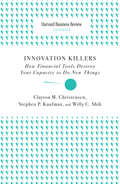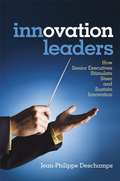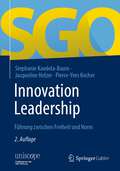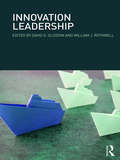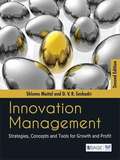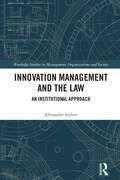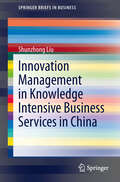- Table View
- List View
Innovation Economics, Engineering and Management Handbook 1: Main Themes
by Dimitri Uzunidis Fedoua Kasmi Laurent AdattoInnovation, in economic activity, in managerial concepts and in engineering design, results from creative activities, entrepreneurial strategies and the business climate. Innovation leads to technological, organizational and commercial changes, due to the relationships between enterprises, public institutions and civil society organizations. These innovation networks create new knowledge and contribute to the dissemination of new socio-economic and technological models, through new production and marketing methods. Innovation Economics, Engineering and Management Handbook 1 is the first of the two volumes that comprise this book. The main objectives across both volumes are to study the innovation processes in today's information and knowledge society; to analyze how links between research and business have intensified; and to discuss the methods by which innovation emerges and is managed by firms, not only from a local perspective but also a global one. The studies presented in these two volumes contribute toward an understanding of the systemic nature of innovations and enable reflection on their potential applications, in order to think about the meaning of growth and prosperity.
Innovation Economics, Engineering and Management Handbook 2: Special Themes
by Dimitri Uzunidis Fedoua Kasmi Laurent AdattoInnovation, in economic activity, in managerial concepts and in engineering design, results from creative activities, entrepreneurial strategies and the business climate. Innovation leads to technological, organizational and commercial changes, due to the relationships between enterprises, public institutions and civil society organizations. These innovation networks create new knowledge and contribute to the dissemination of new socio-economic and technological models, through new production and marketing methods. Innovation Economics, Engineering and Management Handbook 2 is the second of the two volumes that comprise this book. The main objectives across both volumes are to study the innovation processes in today's information and knowledge society; to analyze how links between research and business have intensified; and to discuss the methods by which innovation emerges and is managed by firms, not only from a local perspective but also a global one. The studies presented in these two volumes contribute toward an understanding of the systemic nature of innovations and enable reflection on their potential applications, in order to think about the meaning of growth and prosperity
Innovation Ecosystems (Wiley-iste Ser.)
by Eunika Mercier-LaurentWith innovation fast becoming omnipresent and part of strategic matters, there is a growing need to understand how to jumpstart the innovation process. This book introduces the concept of "e-co-innovation," which fosters the successful transition from idea to reality and ultimate value. It provides a global and system overview of the subject and presents various aspects of innovation from different angles and perspectives, leading to an understanding of all ecosystem components, their metamorphoses, cross-influences and possible impacts on the balanced development of people, businesses, regions and countries.
Innovation Ecosystems and the Role of Communication: Insights from European Science, Technology Parks and Areas of Innovation (Routledge Studies in Innovation, Organizations and Technology)
by Dominika Narożna Justyna AdamskaThis book analyses the role of communication in creating the value of innovation ecosystems from the perspective of the international network of technology parks and areas of innovation. It explores the relations and interactions between different stakeholders (administration, universities, business, innovation agencies), highlighting the important role of communication within successful innovation ecosystems.The role of communication is explained using different levels of communication approach. The authors present communication as a complex process, involving all the ecosystem stakeholders who are as well motivated and involved in different roles, norms, business models, environments, organizations, cultures, etc. The book proposes novel and interdisciplinary research (management, social communication and journalism, political science and administration) focused on the potential of communication in order to design the paradigm and indicate practical implications. The authors take into consideration modern IT tools, which provide the ground for redefining the connections between stakeholders, as well as sustainable development and ESG values, which change the perspective and priorities of the ecosystem.Innovation Ecosystems and the Role of Communication is written for scholars and researchers in the fields of innovation studies, management science, and communication studies.
Innovation Ecosystems: How Driving Forces and Success Factors Affect Opportunities for Business Innovation
by William B RouseThis book is about geography, economics, society, and innovation. Why did different regions evolve in different ways? What caused economic priorities and activities to go in one direction or another? The author believes that happenstance played a relatively minor role in this process. There were and are driving forces, as well as success factors.In each ecosystem, ambitious immigrants arrived, displaced native populations, and proceeded to develop and exploit the geography of their ecosystem, which included leveraging water resources for transportation, commerce, irrigation, etc. They often invented the means of development and exploitation, unfortunately including slavery, but also various technical methods, tools, and devices. Inventions that became innovations enabled industries, revenues, profits, and economic growth, initially for the ecosystem and then more broadly.The impacts of geography and economics are profound. Available resources strongly affect the options available for sustainable economic growth. This growth is fueled by technological innovations that are significantly affected by the physical, economic, and social characteristics of the ecosystem of interest.The eight case studies in this book illustrate how patterns of these characteristics impact innovation. They also depict changes over centuries, rather than just decades or years. Today’s crises are often just blips in the ongoing evolution of an innovation ecosystem. There are ups and downs, but the physical, economic, and social characteristics of the ecosystems dominate their evolution. These factors largely determine what potential innovations are pursued, who leads these pursuits, and why they think they can succeed. People and organizations dominate the factors influencing success.
Innovation Ecosystems: Increasing Competitiveness
by Martin FransmanMartin Fransman presents a new approach to understanding how innovation happens, who makes it happen, and the helps and hindrances. Looking at innovation in real-time under uncertainty, he develops the idea of an 'innovation ecosystem', i.e. a system of interrelated players and processes that jointly make innovation happen. Examples include: how companies like Amazon, Google, Facebook, Apple, AT&T, and Huawei interact in the ICT Ecosystem; four innovations that changed the world - the transistor, microprocessor, optical fibre, and the laser; the causes of the telecoms boom and bust of the early 1990s that influenced the Great Recession from 2007; and the usefulness of the idea of innovation ecosystems for Chinese policy makers. By delving into the complex determinants of innovation this book provides a deeper, more rigorous understanding of how it happens. It will appeal to economists, social scientists, business people, policy makers, and anyone interested in innovation and entrepreneurship.
Innovation Ecosystems: The Future of Civilizations and the Civilization of the Future
by Michel Saloff-CosteOur current situation, marked simultaneously by the Anthropocene, global warming, digitization and exponential artificial intelligence, leads us to sudden and total change in global civilization and, de facto, to rebuilding the foundations of the international economy. Innovation Ecosystems explores the risks and opportunities facing the contemporary world by analyzing, comparing and categorizing the world&’s most dynamic innovation ecosystems by region and city. This includes the identification of key characteristics – common or original – and learning from them in terms of culture, management, system and structure, in order to meet current challenges and think about civilizations of the future.
Innovation Engine
by Jatin DesaiHow to implement an innovation engine in any organization Innovation is often sought and is in high demand today. At the same time it is often misunderstood and lacks committed sponsorship. Today, most teams at the top need an innovation capability in a manner that works in tandem with their performance/operations management. Packed with actionable ideas, references, links, and resources, Innovation Engine meets that need. Reveals how to develop strategy, road maps, and processes for innovation execution Provides high level implementation guidance on executing innovation, something companies are struggling with globally Explores how today's companies can create a long-term sustainable corporate culture by also using an innovation engine Explains how to use innovation to keep employees engaged and motivated Written for executives, business leaders, CFOs, and CIOs Showing readers how to create a business case for innovation and a supporting innovation linked to business vision and goals, Innovation Engine clearly reveals how to reduce time-to-market, while expanding the "idea landscape" and building a pipeline of corporate innovators.
Innovation Engines: Entrepreneurs and Enterprises in a Turbulent World
by Dimitri Uzunidis Pierre SaulaisIn an uncertain economy where business risk is significant, the company tends to rely more on its environment than to invest, for example, in all steps of technological creation; This can be explained by the fact that investments in the acquisition (ownership) of production resources are less expensive than those implied in the formation of these resources; which also explains the attractiveness (in an open economy) of regions with abundant scientific and technical resources. To understand and analyze the innovation process in order to better design and launch new goods, services and technologies, one has to consider the creative dimension of the individual, the business and the organization in general. In new approaches to innovation, the entrepreneur and the company are analyzed through their skills, and their function of resource generation; Innovation thus becomes endogenous, gradual or radical, integrated in a complex process with many feedbacks and interactions. The innovative organization (small or large) is presented in this book as a dynamic system composed of specific and diverse skills (including those of the contractor, engineers or managers). By acquiring, combining and mobilizing these skills, the innovative agent (entrepreneur or company) can create technological resources and develop relations with its environment. Hence the importance of management in design, implementation, protection of intellectual property as well as of the development of new goods, services and technology, commercial and organizational models.
Innovation Equity: Assessing and Managing the Monetary Value of New Products and Services
by Elie Ofek Barak Libai Eitan MullerFrom drones to wearable technology to Hyperloop pods that can potentially travel more than seven hundred miles per hour, we're fascinated with new products and technologies that seem to come straight out of science fiction. But, innovations are not only fascinating, they're polarizing, as, all too quickly, skepticism regarding their commercial viability starts to creep in. And while fortunes depend on people's ability to properly assess their prospects for success, no one can really agree on how to do it, especially for truly radical new products and services. In Innovation Equity, Elie Ofek, Eitan Muller, and Barak Libai analyze how a vast array of past innovations performed in the marketplace--from their launch to the moment they became everyday products to the phase where consumers moved on to the "next big thing." They identify key patterns in how consumers adopt innovations and integrate these with marketing scholarship on how companies manage their customer base by attracting new customers, keeping current customers satisfied, and preventing customers from switching to competitors' products and services. In doing so, the authors produce concrete models that powerfully predict how the marketplace will respond to innovations, providing a much more authoritative way to estimate their potential monetary value, as well as a framework for making it possible to achieve that value.
Innovation Finance and Technology Transfer: Funding Proof-of-Concept (Routledge Studies in Innovation, Organizations and Technology)
by Andrea AlunniOffering proof-of-concept (POC) to inventors is often a difficult task for most Technology Transfer Offices (TTOs). Through an in-depth analysis of 15 years of IP portfolio management by Oxford University Innovation (OUI), this book identifies the salient aspects of the technology transfer evolution and the role that technology transfer managers (TTMs) play in closing the gap between academia and business. Innovation Finance and Technology Transfer: Funding Proof of Concept seeks to prove that a well-managed POC Fund can achieve positive financial results and that the chances for an IP portfolio management to be "in the money" increases if the TTO is attached to an entrepreneurial University. This work illustrates how innovation based on Intellectual Property Rights protected and managed by a highly-skilled group of technology transfer managers succeeds in technology transfer. It offers a vademecum to practitioners to follow a step by step best practice procedure embraced by the Oxford TTO to manage the POC investment process. This book is valuable reading for intellectual property scholars, business school students, social sciences researchers, investment professionals and technology transfer practitioners, as well as those working in innovation think tanks and policy circles.
Innovation Fundamentals: Quantitative and Qualitative Techniques (Systems Innovation Book Series)
by Adedeji B. Badiru Gary LamontThe book uses a systems-based approach to show how innovation is pervasive in all facets of endeavors, including business, industrial, government, the military, and even academia. It presents chapters that provide techniques and methodologies for achieving the transfer of science and technology assets for innovation applications. By introducing Innovation, the book and offers different viewpoints, both qualitative and quantitative. It includes the role that systems can play and discusses approaches along technical and process issues. There is a showcase of innovation applications, and coverage on how to manage innovation individually as well as within a team and it also includes how to develop, manage, and sustain innovation in various organizations. Open-ended questions and exercises are included at the end of chapters with no need for a solutions manual. Written for the advance-level textbook market as well as for the professional reader, it targets those within the engineering, business, and management fields.
Innovation Governance
by Beebe Nelson Jean-Philippe DeschampsThe business leader's guide to encouraging continuous innovation in any organizationInnovation governance is a hot topic in the business world. In a fast-paced business environment, the ability of corporate leaders to build purpose, direction, and focus for innovation is more important than ever. In this book, the authors provide a framework for encouraging and focusing innovation by explaining what innovation governance is, the various models for governance and their advantages and disadvantages, how to assess and improve governance practices, and behavioral tactics for maximizing the effectiveness of governance. It offers guidance for everyone from the boardroom through senior management, illustrating effective governance models with real case studies from a range of companies in the United States and Europe.Addresses an important yet underappreciated skill for CEOs, board members, and top managementFeatures real-world examples and case studies from a variety of business from around the worldWritten by an author team with hands-on experience in the subjects of innovation management, organizational learning, innovation leadership, organizational behavior, and individual leadership and teamworkInnovation governance is a sadly neglected topic in many organizations. This book offers vital guidance and real-world experience for building innovation into any business from the top down.
Innovation Governance in an Open Economy: Shaping Regional Nodes in a Globalized World (Regions and Cities)
by Henry Etzkowitz Annika Rickne Staffan LaestadiusIn an increasingly globalised world, paradoxically regional innovation clusters have moved to the forefront of attention as a strategy for economic and social development. Transcending international success cases, like Silicon Valley and Route 128, as sources of lessons, successful high tech clusters in niche areas have had a significant impact on peripheral regions. Are these successful innovation clusters born or made? If they are subject to planning and direction, what is the shape that it takes: top down, bottom up or lateral?
Innovation Intermediaries and (Final) Frontiers of High-tech: Supporting the New Space Sector in Scotland
by Matjaz VidmarThis book synthesizes the critical advances in holistic understanding of innovation intermediation. It aims to enable researchers, policy-makers, analysts and practitioners to understand and exploit the best practice in designing and deploying interventions in support of an emergent high-tech geographically-bound sectoral innovation system. The book presents a systematic review of innovation intermediaries’ literature and mixed-methods empirical evidence across a range of projects, building a new comprehensive model of activities and resources deployed.The book highlights the emerging New Space industry in Scotland as a primary case study, but lessons learned can applied to scholarly analysis, policy and operational design of all innovation intermediaries’ interventions, which makes this book essential reading in management, innovation studies, political studies and sociology of technology.
Innovation Intermediaries: Enabling Open Innovation
by Henry ChesbroughThis chapter discusses the rise of innovation intermediaries, or firms that help companies of many different sizes participate in the emerging secondary markets for innovation and IP and craft more open business models.
Innovation Killers: How Financial Tools Destroy Your Capacity To Do New Things
by Clayton M. ChristensenIn this seminal article, innovation experts Clayton Christensen, Stephen P. Kaufman, and Willy C. Shih explore the key reasons why companies struggle to innovate. The authors uncover common mistakes companies make--from focusing on the wrong customers to choosing the wrong products to develop--that can derail innovation efforts, and offer a better way forward for management teams who want to avoid these obstacles and get innovation right.
Innovation Killers: How Financial Tools Destroy Your Capacity to do New Things (Harvard Business Review Classics)
by Clayton M. Christensen Willy C. Shih Stephen P. KaufmanIn this seminal article, innovation experts Clayton Christensen, Stephen P. Kaufman, and Willy C. Shih explore the key reasons why companies struggle to innovate. The authors uncover common mistakes companies make--from focusing on the wrong customers to choosing the wrong products to develop--that can derail innovation efforts, and offer a better way forward for management teams who want to avoid these obstacles and get innovation right.
Innovation Leaders
by Deschamps Jean-PhilippeInnovation leaders promote and address the innovation agenda in their company. Through personal conviction or competitive necessity they are obsessed with providing superior value to customers through innovation. They know how to mobilize their staff behind concrete innovation initiatives and do not hesitate to personally coach innovation teams. For innovation to occur leadership has to be collective. To create a momentum for innovation in their company, leaders from different functions need to team up, to build innovation networks. Innovation leadership is not just an innate talent that can be selected at the hiring level. It can be developed within an appropriate company culture through careful leadership development, typically achieved through career management and coaching. Innovation leaders also need to stay on board and it is the responsibility of the top management team to create an attractive climate to develop and keep its innovation leaders. There are plenty of books that deal with innovation, or with new product development, or with leadership; this is different in its focus on the specifics of innovation leadership - that particular form of leadership that stimulates and sustains innovation. This book maps the broad territory of innovation leadership and contributes new thinking on the focus of the emerging leadership role of the CTO; distinction between 'front end' and 'back end' innovation leaders; the concept of aligning leadership styles with strategy; and the chain of leadership concept. Combining practice-based and empirical research-based observations with simple conceptual frameworks, illustrated by many company examples and case stories from a broad range of industries in the US and Europe, this is a systematic presentation of innovation drivers and their implications in terms of what leaders need to do to make it work.
Innovation Leadership: Führung zwischen Freiheit und Norm (uniscope. Publikationen der SGO Stiftung)
by Stephanie Kaudela-Baum Jacqueline Holzer Pierre-Yves KocherWir befinden uns mitten in einer modernen industriellen Revolution, in der Innovation eine entscheidende Rolle für den Unternehmenserfolg spielt und innovationsfördernde Führung wichtiger ist denn je. Immer mehr Unternehmen integrieren Technologien wie künstliche Intelligenz, Machine Learning und Data Science in ihre Prozesse und es gilt, Mitarbeitende zu entwickeln und neu zu rekrutieren, die diese Technologien beherrschen. In diesem Buch erfahren die Leserinnen und Leser anhand zahlreicher Beispiele, wie der Drahtseilakt zwischen einer stetigen Weiterentwicklung des Kerngeschäfts und der Etablierung neuer Wege und Denkweisen durch Kreativität gelingt. Eine Fähigkeit, die gerade im Zeitalter der Digitalisierung an Bedeutung gewinnt. Die Autorinnen und der Autor richten den Fokus auf die Beziehungsgestaltung zwischen Führenden und Geführten zur Förderung der Innovationsfähigkeit und entwickeln ein Innovation- Leadership-Modell (kurz: InnoLEAD). Dieses Modell unterstützt Führungspersonen dabei, sich im Spannungsfeld zwischen Exploitation und Exploration zu orientieren und ihre eigene Rolle zu reflektieren. Zudem werden strategische, strukturelle und kulturelle Dimensionen der Organisations- und Personalentwicklung aufgegriffen. Zahlreiche Praxisbeispiele illustrieren das Modell. Für die 2. Auflage wurden neue Fallbeispiele integriert und aktuelle Theorien, Konzepte und Forschungsergebnisse aufgenommen.
Innovation Leadership: Innovation Into Action (Leadership Network Innovation Ser. #0)
by William J. Rothwell David G. GliddonA leader's ability to discover and implement innovations is crucial to adapting to changing technologies and customer preferences, enhancing employee creativity, developing new products, supporting market competitiveness, and sustaining economic growth. Gliddon and Rothwell provide an exciting and comprehensive resource for readers that are currently seeking to build success in organizations with new ideas. Innovation leadership involves synthesizing different leadership styles in organizations to influence employees to produce creative ideas, products, services, and solutions. It is a practice and an approach to organization development and organizational change. Innovation leadership commonly includes four basic stages, which are: (a) support for idea generation, (b) identifying innovations, (c) evaluating innovations, and (d) implementation. There are two types of innovations, including: (a) exploratory innovation, which involves generating brand new ideas, and (b) value-added innovation, which involves modifying and renewing ideas that already exist. The two fundamental leadership theories that are generally necessary for innovation leadership are path-goal theory and Leader Member Exchange theory. The key role in the practice of innovation leadership is that of the innovation leader. However, there are currently multiple perspectives on the definition of an innovation leader. An individual in an organization, a group within an organization, the organization itself, and even a community, state, or nation can be considered an innovation leader. The book explores each of these perspectives on the definition of an innovation leader.
Innovation Management
by Professor Shlomo Maital D V SeshadriInnovation Management: Strategies, Concepts and Tools for Growth and Profit is a unique book in the rapidly growing discipline of Innovation Management. It seeks to build on the experience from an earlier discipline--Competitive Strategy. It took more than two decades for practitioners to realize that successful strategy is driven by implementation, not by formulation. Similarly, successful innovation--the key to growth and profit--rests on disciplined management and implementation of the innovation process from start to finish. This book first answers the key questions: Why innovate? How to innovate? Who innovates? It then provides 10 essential and practical tools to help innovators guide their ideas to marketplace success. Following the publication of the successful first edition, and in response to many readers' positive feedback for its case studies, the second edition contains a large number of new mini case studies about innovative start-ups, businesses, and ideas in the period of 2007-12 Innovation Management shows how companies and individuals can transform creative ideas into powerful, sustainable, change-the-world businesses and emphasizes the crucial role of execution in implementing inspiring ideas.
Innovation Management and the Law: An Institutional Approach (Routledge Studies in Management, Organizations and Society)
by Alexander StyhreIn economic theory and in management studies, innovation is widely regarded as the motor of economic activities and as being the primary source of renewal in the economic system. This view emphasizes how innovation work is organized in specialized teams inside the firm, or, alternatively, located to start-ups and similar small ventures that are strongly incentivized to innovate to survive. Rather than assuming that innovation work is a mere product of incentives provided by the market system, propelled by the individual and collective skills of the innovation team participants and the resources that they mobilize in their work, this volume examines how a market for innovation ideas is being constructed on the basis of policy making and legislative activities. Innovation Management and the Law examines how the idea of value creation is understood to be a matter of innovation activities and how such innovation activities are premised on legal rights that create not only incentives, corporations, and markets, but also more widely signal to market actors what kind of activities are consistent with policy makers’ economic and social welfare objectives. The volume thus adds to the innovation management literature by introducing a comprehensive analysis of the patent system, illustrating that the patent system is itself an institution and that it should be examined in such terms when studying how innovations are generated on the basis of team production activities and legal rights that are enforceable. It will be of interest to researchers, academics, professionals, and advanced students in the fields of management, economic theory, and law.
Innovation Management by Promoting the Informal
by Markus Bürgermeister Fritz Böhle Stephanie PorschenThis book explores new approaches to successful innovation - with all uncertainty. Its focal points are management of the informal and a new perspective of human work: innovation work is based on artistic, experience-based and playful action. The book helps recognize and utilize new success potentials for innovation in enterprises. It addresses managers and experts who are interested in promoting innovation in practice. Moreover, scientists will gather new interdisciplinary insights into innovation management and work organization from this book.
Innovation Management in Knowledge Intensive Business Services in China
by Shunzhong LiuIn a knowledge-based economy, the development of a particular type of services, knowledge intensive business services (KIBS), becomes one of the characteristic trends in economic evolution. Current research focuses mainly on service innovation in developed countries, but little consideration is given to the situation in developing countries. Based on empirical research in the People's Republic of China, this book aims to contribute to a better appreciation and understanding of the innovative characteristics of KIBSs in developing countries.
